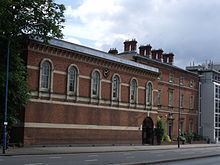Established 1887 Local authority Founded 1887 | Closed 1976 Religion Roman Catholic Motto Pietas | |
 | ||
Location Hagley RoadEdgbastonWest MidlandsB16 8UFEngland | ||
St. Philip's Grammar School, in Hagley Road, Edgbaston, Birmingham, was a Roman Catholic grammar school for boys. It was closed in 1976, with the introduction of comprehensive education.
Contents
History
St Philip's was founded when two priests of the Birmingham Oratory took over an existing Catholic Grammar School in 1887. It should not be confused with the Oratory School founded by Cardinal Newman in 1859 and later moved to Pangbourne, near Reading.
The school started in the Little Oratory on 19 September 1887 until the main building was completed on 13 December 1887. The longest-serving teacher in the school's history was Francis Thomas Leighton,who served as "Second Master" (Deputy Head) from 1911 until 1945, having served as Headmaster when the School was evacuated to Ludlow in 1941. His two sons, and later, grandson, also attended the school. FT Leighton finally left to found an independent Preparatory School, Leighton House School, serving as a "feeder" school for St Philip's. The school ceased to accept new entrants as a boys' Grammar School in 1976, while the 1975 cohort progressed through to 1980.
Sixth form college
It became St Philip's Roman Catholic Sixth Form College in 1976, with around 800 sixth formers. In October 1992, due to only 30% of the intake being Catholic, the board of governors unsuccessfully attempted to change it to an 11-16 boys' secondary school, resulting in the Hagley Road site closing in August 1995. It temporarily became a site of South Birmingham College from 1995 but was vacated in 2005.The main school buildings were demolished in the early months of 2012.
